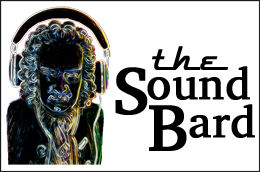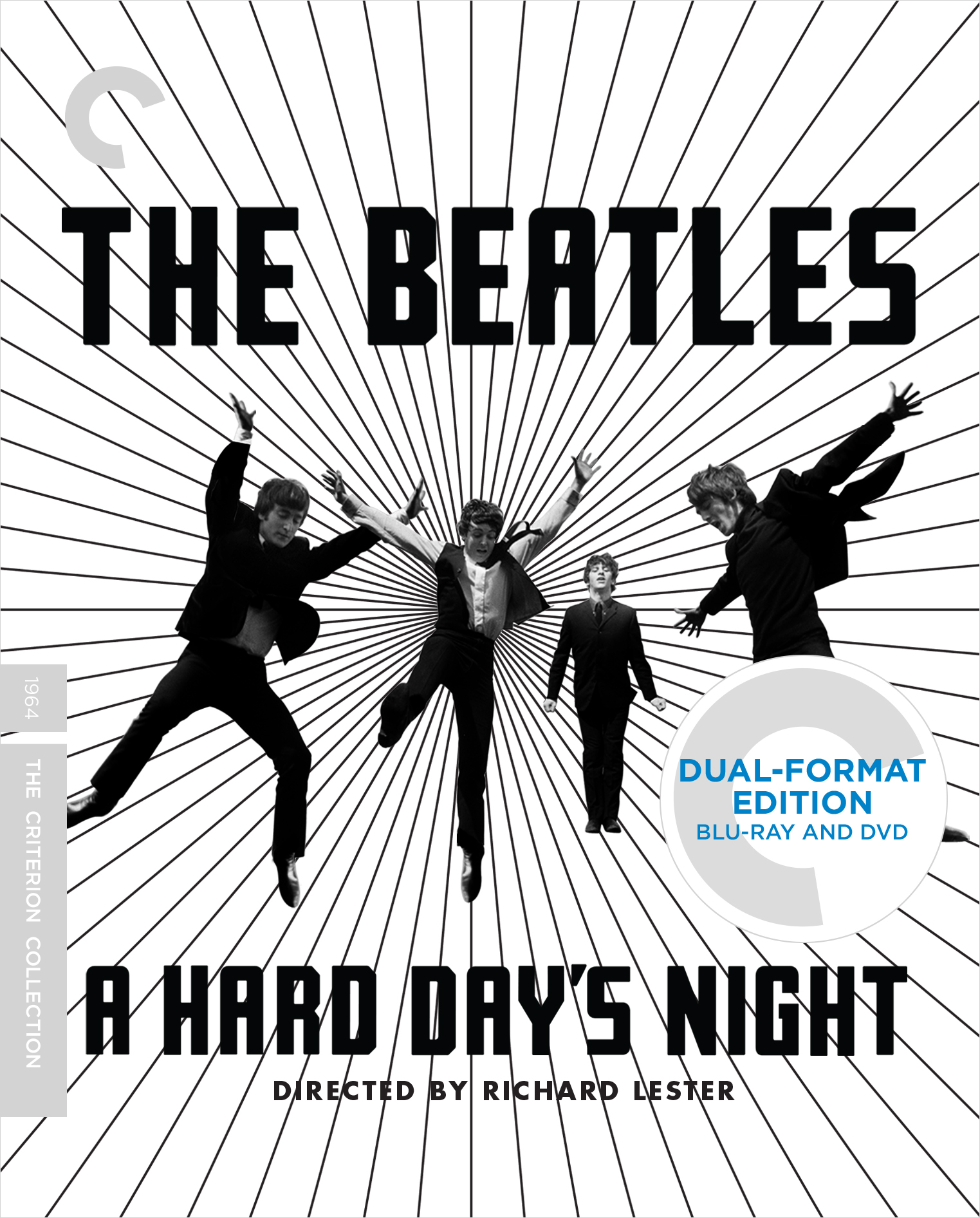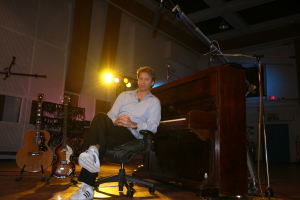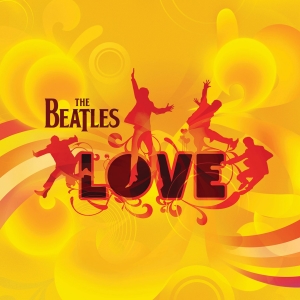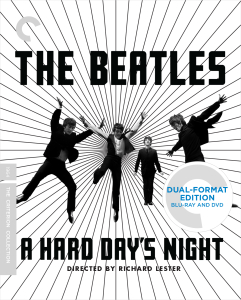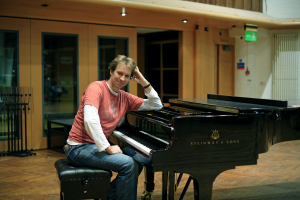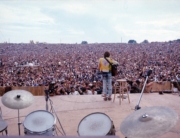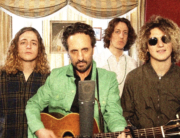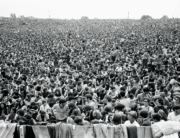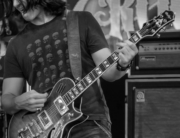BY MIKE METTLER — JUNE 25, 2014
“I’m just into the ethos of having great sound,” says Giles Martin, describing his surround sound mixing philosophy. “The intention of what we do is to make the journey as seamless as possible. I want people to enjoy what they’re listening to without thinking about it.” Martin’s “natural surround” philosophy is in full effect with the stellar 192-kHz/24-bit 5.1 mix he’s done for the 50th anniversary of A Hard Day’s Night, released on June 24 by The Criterion Collection in a Director-Approved Dual-Format Blu-ray and DVD Special Edition. (If you want to experience the film in a theater setting, it will be playing in almost 100 cities across the country on July 4, courtesy of Janus Films. Theaters and cities can be found by clicking here.)
Martin, son of The Beatles’ original producer Sir George Martin, continues his holy 5.1 Beatles mission with smart, inviting, and enveloping 192/24 mixes all throughout the film, in which he also has to balance the presence and presentation of The Fab Four’s music with hordes of hysterically screaming audiences in street, train station, and television studio settings. And the music itself is spot-on: “I Should Have Known Better” features center-channel-centric harmonies and harmonica, George Harrison’s guitar solo in the front right, and natural acoustic-guitar delay in the rears, while the exuberant, centered lead vocals on “She Loves You” give way to a proper-echoed impact when the music briefly drops out and the boys deliberately enunciate the words “with a love like that” in all channels. (Three words: Yeah yeah yeah!)
Martin, 44, and I recently came together to discuss his surround goals for A Hard Day’s Night, why his 5.1 LOVE mix still endures, and what Beatles album he’d like to do next in surround. One thing’s for sure: Whether they’re running, jumping, or standing still, The Beatles are totally fab in 5.1.
Mike Mettler: Was it difficult getting A Hard Day’s Night‘s soundtrack up to master quality?
Giles Martin: It’s funny — the music, of course, is the easy bit. We go through the process of converting all of the Beatles stuff into higher and higher resolution each time around, and now we have 192/24 versions of these songs. The hard part is matching them with the dialog, which is not of high quality, so you have to bring it down, as you could have hi-res songs interlaced with low-res sound effects and speech. So it’s a process getting that balance right, but it’s a fun process. It’s an interesting thing to explore.
Mettler: Do you feel 192/24 is the best representation of Bealtes music moving forward?
Martin: Yeah, though I do think 96/24 is also pretty good, to be honest. So “yes” is the answer. [chuckles] If you’re doing something with multitrack recordings, then 192 is brilliant. We’re at an age where very high-resolution audio is producing a perfect facsimile of what we have in the vaults. I know there are those who don’t like the idea of that because some people like the sound of vinyl better, but it’s simply the case.
Mettler: Is there one particular track you’d consider the benchmark for what you wanted to achieve in surround?
Martin: Well, “A Hard Day’s Night” is a difficult template, because the nature of the recording is it’s got the full bandwidth where the highs and the lows are at their peaks. I would say, for instance, if you compared the mix we did here of “Can’t Buy Me Love” with the mix of the original, it’s much more rocking. Now, it’s not more rocking because we’re sampling or compressing anything — it’s just as we bring off the layers, we get a lot more energy from the band. And that’s the key for me: to get the energy across, because it’s 1964 and the band are young, and they’re punching it out through the speakers.
Mettler: That’s especially true in the back half of the film, when they’re performing in the TV studio in front of the screaming audience. “I Should Have Known Better,” “She Loves You,” and “A Hard Day’s Night” are at the crux of the performance, and the energy level is palpable.
Martin: I’m pleased that you got that, because that’s what we were trying to do. I want people to feel what I’ve pulled from the original tapes. And my North Star, if you like, is to gather people to feel the same way.
Mettler: You’ve been doing that ever since you did the surround mix for LOVE [in 2008].
Martin: Well, that’s been the plan — to try and get people to hear music in that way. It is a different experience.
Mettler: I totally agree. I’ve seen the LOVE show in Vegas five times, and —
Martin: That’s quite a bit of money.
Mettler: It’s totally been worth it. And the DVD-Audio 5.1 version that you guys put together is still fabulous to my ears.
Martin: I don’t mean to say this arrogantly, but I think it’s still one of the best surround discs around.
Mettler: You can say it. You took some of the best music we have in the modern era and put it out in the best form possible. That’s total win-win, Giles.
Martin: Ok, yeah, yeah, that’s true. [chuckles]
Mettler: Since there’s a 14-LP The Beatles in Mono box set coming out on vinyl [on September 9], I think you need to do The Beatles in Surround box on Blu-ray. What do you say?
Martin: [laughs] Yeah, there’s been talk about that. When I did LOVE in surround, I thought, “This is it. It’s groundbreaking. People are going to react to this!” And then I realized I couldn’t play it anywhere. So that’s the thing to get across. I’ve been working on a system where we can actually get surround correct in people’s homes. And then we can open this world up. But it’s very tough to do that, because it can be set up so wrong in so many homes. It’s also about the manufacturers getting it right as well.
Mettler: You had 2-track and 4-track recordings to work with for the most part, but you were only able to find “She Loves You” in mono. What did you have to do to spread that one out?
Martin: We tried these groundbreaking techniques of de-mixing — we haven’t gotten it quite right yet, but we’re really close — so we could have some separation of the low end. What we do is we play around with it, and we just try to push the envelope as much as we can. We put “She Loves You” back through Studio Two at Abbey Road Studios, and re-recorded where the band were, and tried to find a room sound. And then we put it in surround.
Mettler: How did you work out the level balances in the scenes where you have music playing along with the audience screaming?
Martin: We used the original tracks, and we did some Foley with the girls screaming from the offices upstairs to create a more immersive experience. [Foley is the term for reproducing sound effects that are added to a film in post-production to enhance audio quality—Your Film-Scholarly SoundBard] It’s that thing where if you’re watching something and not hearing the right thing, it becomes distracting for the viewer. And I think the intention of what we do is make that journey as seamless as possible.
Mettler: You had to deal with tracks being slowed down during the rehearsal sequences because of the different frame rates per second. [Scenes in the film were shot at 25 frames per second instead of the usual 24 frames per second, so The Beatles’ rehearsals and performances in the television studio were slower than the songs appear on the original albums so that the TV monitors shown onscreen wouldn’t display any flickering effects—Your Behind-the-Scenes SoundBard]
Martin: Yeah, it’s funny. I could have put the tracks at the right pitch, but I would have had to do that digitally. And that kind of gets into the sensibilities of what we’re working towards. The only way you can do it without changing the pitch and without changing the time is by doing it digitally. People will say, “Oh, it’s getting better and better,” but to me, it goes against what we’re trying to do here. Someone might say, “Speed up the film so we can get the tracks right, mate,” and we’d say, “No, we’ll keep it as it was.” I keep it as purist as possible, really.
Mettler: You kept George Harrison’s guitar solos pretty much in the right channel.
Martin: I do what I think is the right thing to do. Because I could easily change the whole weight of the mix of the sound.
Mettler: As for the vocals, you’ve got to have those harmonies distinct and clear, so you have them centered.
Martin: The main thing about putting the vocals in the center is when you’re watching the film, the voices aren’t jumping from different perspectives. When the boys are talking, they’re in the center. And when they’re singing, they’re in the center. And then when it comes to the music, I don’t have to build around and out. As to where things go, I do try to keep it as the original mix was, because the papers will then be saying it was me changing the mix. You can’t just do things the same way they were done and not end up thinking, “Well, does this feel right to me?”
Mettler: Point taken. If the vocals and dialog were coming from all around you, you’d be distracted from what’s going on in the film, and you need that summed and centered so you can get a sense of the story. When the scenes change into the musical pieces, you then open it up a bit.
Martin: Yeah, exactly. Exactly. The intention of all of it is for people to enjoy the film without thinking about anything having to do with the mix.
Mettler: Looking ahead, is there a particular Beatles album you’re champing at the bit to get to mixing in surround?
Martin: I think The White Album in surround would be fabulous. But there has to be a reason to do this stuff. There has to be an impetus behind it, do you know what I mean — not just us so-called experts being selfish about it. [both chuckle] I like the idea of doing another LOVE-type show where I’d design where the speakers go, perhaps even as a walkthrough kind of experience.
Mettler: What is your philosophy about the best way to listen to surround?
Martin: There’s a chain at work, from what we do in the studio down to how you get it at home. And the world is changing rapidly in terms of how we get digital media into the home. We have to ensure that the 5.1 channel is kept open. I don’t want to force people to buy speakers they’re not going to use, but at the same time, you can’t really have surround without having rear speakers. My philosophy is to make it as simple as possible. And you want people to not realize that’s what they want; that they enjoy what they’re listening to without thinking about it.
Mettler: You’ve been listening to and mixing in surround for a long time. What surround mixes stand out to your ears, good or bad?
Martin: In the early days of surround, I was given a Marvin Gaye disc, and the guitarist played behind me. I would never go to a gig where I was standing next to the kick drum and the guitarist was playing behind me! The [Beach Boys’] Pet Sounds surround was pretty terrible, but I thought [Pink Floyd’s] The Dark Side of the Moon was great.
Mettler: James Guthrie did a great job with that one on SACD, yes.
Martin: Yeah, I was so delighted when I heard that. I thought, “Great! There’s another surround disc I can listen to.” I have a button on my desk that switches from the stereo mix to the surround mix — and I also have a button that can go to a mono mix, of course. When I switch to my surround setup, what I don’t want to notice is things going multidirectional, but more that I’m closer to everything. That’s what’s great about what you can do with surround.
I’m just into the ethos of having great sound, and I’d be happy if people had access to 192 or whatever it is. But I don’t want people to think about it; I just want people to listen. You want people to have the experience to be able to hear music, even if it’s from a mono speaker in the back of a car, and get that great feeling where they go, “We have a connect.” And whether it’s a connect between the mixing board and the sound or a connect between a memory and the sound — as long as there’s a connect there, and it’s not just noise, that’s the key.
Mettler: Let’s wrap up with your final assessment of A Hard Day’s Night. Did you achieve your goals with the surround mix?
Martin: I don’t know if that’s up to me to decide.
Mettler: Ok, I’ll decide. I think it’s great.
Martin: Thank you. Well, let me put it this way: If I hadn’t have done that, we wouldn’t have put it out. I’ll tell you what I wanted to achieve: I wanted people to listen to the band thinking that it’s just a great band.
Tags: 192/24, 5.1, 96/24, A Hard Day's Night, Abbey Road Studios, Can't Buy Me Love, George Harrison, George Martin, Giles Martin, High Resolution Audio, I Should Have Known Better, John Lennon, LOVE, Paul McCartney, Ringo Starr, She Loves You, Studio Two, surround sound, The Beatles, The White Album